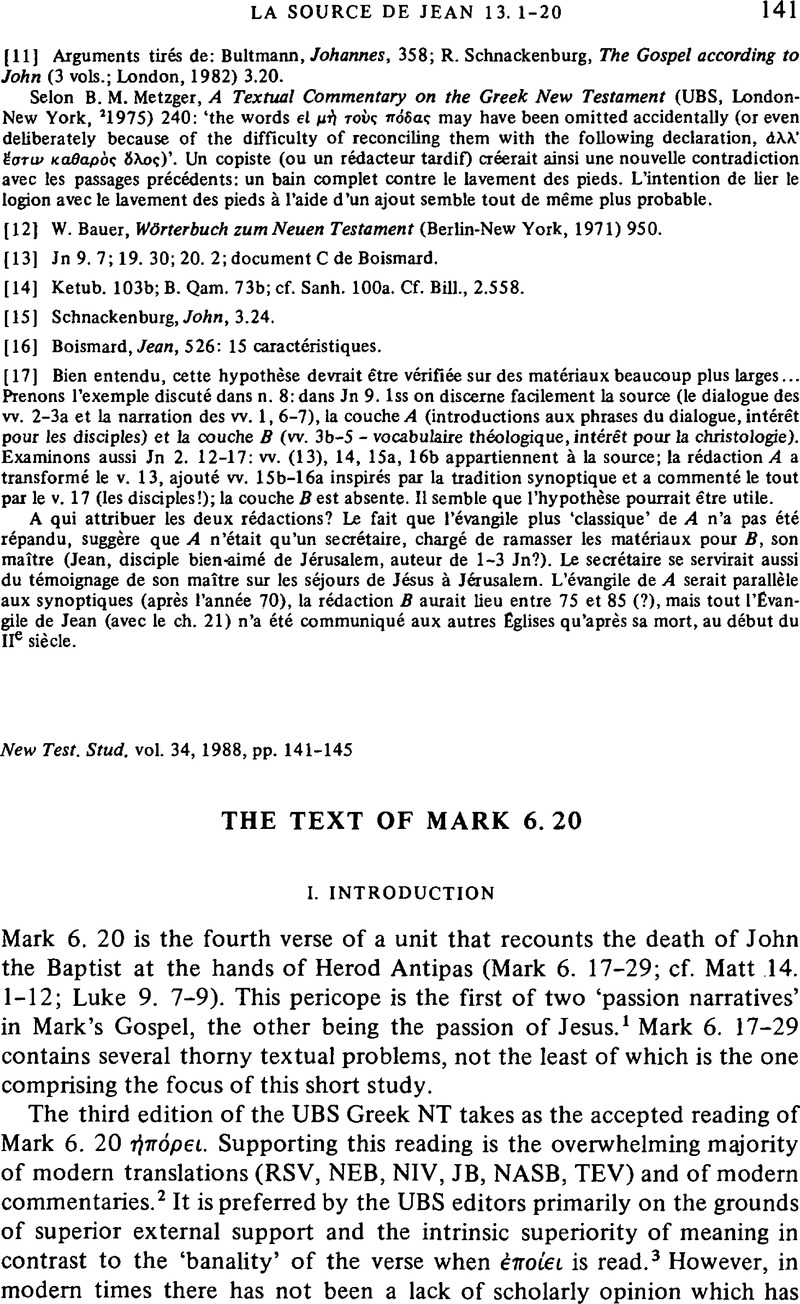No CrossRef data available.
Published online by Cambridge University Press: 05 February 2009

[1] The account of John's execution in Mark 6. 17–29 prepares the way for the first announcement by Jesus of his own sufferings in 8. 31 and for the more sombre part of the Gospel which is to follow (see Schrenk, W., ‘Gefangenschaft und Tod des Täufers. Erwagungen zur Chronologie und ihren Konsequenzen’, NTS 29 [1983] 453–83).CrossRefGoogle Scholar Moreover, Bennett, W. J. has shown that the link between the enemies of Jesus and the enemies of John are the ‘Hρωδıανοί, the ‘Herodians’ (‘The Herodians of Mark's Gospel’ NovT 17 [1975] 9–14).Google Scholar Hence a correct understanding of the account of John's death is a necessary corollary to a correct understanding of the account of Jesus' execution.
[2] Of the more recent commentators on Mark, only Hiebert, D. E. raises any doubts about ήπόρει (Mark: A Portrait of the Servant [Chicago: Moody, 1974] 150).Google Scholar But see the interesting conjecture of Torrey, C. C., The Four Gospels: A New Translation (London: Hodder and Stoughton, n.d.) 299.Google Scholar
[3] Metzger, Bruce, A Textual Commentary on the Greek New Testament (London: United Bible Societies, 1971) 89.Google Scholar The editors seem to be unaware of several older studies which have defended έποίει and have offered plausible interpretations of Mark 6. 20 when the word is retained. See Whitney, S. W., The Reviser's Greek Text (Boston: Silver, Burdett & Co., 1892) 198–9;Google ScholarScrivener, F. H. A., A Plain Introduction to the Criticism of the New Testament (4th ed.; London: George Bell & Sons, 1894) 2. 335;Google ScholarWebster, C., ‘St. Mark vi. 20’, ET 49 (1937) 93–4;Google ScholarBonner, C., ‘Note on Mark 6:20’, HTR 37 (1944) 41–44;CrossRefGoogle Scholar‘Additions and Corrections, Mark 6:20’, HTR 38 (1944) 336. The present article seeks to develop its own independent line of argumentation and to complement these earlier studies.Google Scholar
[4] With some truth the Alexandrian text has been called the new Textus Receptus, and it is unusual to find an instance in which the editors of the UBS Greek NT confidently depart from a reading supported by Codex B. For criticisms of this excessive reliance upon the ‘best’ manuscripts, see Elliot, J. K., ‘The United Bible Societies' Textual Commentary Evaluated’, NovT 17 (1975) 130–50;Google Scholar‘The Third Edition of the United Bible Societies' Greek New Testament’, NovT 20 (1978) 242–77;Google Scholar‘An Examination of the Twenty-sixth Edition of Nestle-Aland Novum Testamentum Graece’, JTS 32 (1981) 19–49;Google ScholarNeirynck, F., ‘The New Nestle-Aland’, ETL 55 (1979) 331–56;Google ScholarBartsch, H.-W., ‘Zur Problematick eines Monopoltextes des Neuen Testaments’, TLZ 105 (1980) 91–6;Google ScholarEpp, E. J., ‘A Continuing Interlude in New Testament Textual Criticism?’, HTR 73 (1980) 131–51;CrossRefGoogle ScholarRoss, J. M., ‘Some Unnoticed Points in the Text of the New Testament’, NovT 25 (1983) 59–72;Google Scholar and especially Moir, I. A., ‘Can We Risk Another “Textus Receptus”?’, JBL 100 (1981) 614–18.Google Scholar
[5] Metzger, Textual Commentary, xxviii. For other examples where almost all the ‘good’ manuscripts may be in error, see Black, D. A., ‘The Peculiarities of Ephesians and the Ephesian Address’, GTJ 2 (1981) 59–73;Google Scholar‘The Text of John 3:13’, GTJ 6 (1985) 49–66.Google Scholar
[6] Hendricksen, W., The Gospel of Mark (Grand Rapids: Baker, 1975) 237.Google Scholar
[7] Kilpatrick, G. D., ‘Some Notes on Marcan Usage’, BT 7 (1956) 7–8.Google Scholar
[8] Both έποίι and ![]() κουεν appear to be iterative imperfects.
κουεν appear to be iterative imperfects.
[9] περίλυπος is the same word used by Mark to describe Jesus' agony in Gethsemane (Mark 14. 34).
[10] The author is grateful to Professor Harry Sturz of Biola University for helpful criticisms of an earlier draft of this paper.